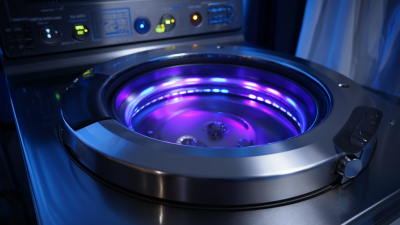How to Accurately Perform Benedict's Test: Insights from 90% of Clinical Laboratories
Table of Contents
- Understanding the Principle of Benedict's Test in Clinical Settings
- Common Sources of Error in Performing Benedict's Test
- Standard Procedures for Conducting Benedict's Test Across Laboratories
- Interpreting Results: Quantifying Glucose Levels with Benedict's Test
- Importance of Sample Handling and Preparation in Accurate Testing
- Trends in Laboratory Practices: The Shift Towards Automated Testing Methods
- Comprehensive Guide to the Veterinary Rapid Diagnostic Test Kit: Enhancing Animal Healthcare Efficiency and Accuracy
- FAQS
- Conclusion
- Related Posts
Benedict's Test is pretty much a cornerstone when it comes to diagnosing reducing sugars in urine. It’s a handy tool that gives us pretty important clues about how our body handles carbs and can even hint at health problems like diabetes. From what we’ve seen—over 90% of clinical labs use this test—it’s super important to get it just right. If you don’t perform it accurately, the results might not tell the full story, and that can impact patient care. Here at Zhejiang Pushkang Biotechnology Co., Ltd., we’re all about pushing the boundaries of diagnostic methods with new and better technology. Since we started back in 2014, our focus has been on researching, producing, and promoting IVD products—mainly using our innovative centrifugal microfluidics platform. We’ve got broad expertise in creating point-of-care testing (POCT) devices, covering areas like coagulation, biochemistry, CLIA, and molecular diagnostics. Essentially, our goal is to make sure healthcare professionals have access to top-notch tools—like precise Benedict's Test procedures—so they can make accurate diagnoses. We hope this overview sheds some light on how critical this test is in everyday clinical practice and helps folks understand it a bit better.

Understanding the Principle of Benedict's Test in Clinical Settings
Benedict's Test is actually pretty important when it comes to checking for reducing sugars, especially glucose, in urine or other samples. The way it works is pretty neat: it relies on an oxidation-reduction reaction between those sugars and the copper(II) sulfate in the Benedict's reagent. Basically, when you heat a sample that has reducing sugars with this reagent, the copper ions get reduced and form a colored precipitate. The cool part? The color change—going from green to brick-red—tells you roughly how much sugar is present. This makes it super useful in clinics, like for keeping an eye on conditions like diabetes.
Now, in a lab setting, getting accurate results really matters. It’s all about proper sample collection and handling—if you mess that up, you might get unreliable results. You also have to be careful with details like controlling the temperature when heating and timing the reaction just right. And don’t forget—understanding what the results mean is key. A positive result might mean you need to do more tests or take some action. That’s why it’s so important for lab techs to be well-trained, not just in how the test works theoretically but also in the practical stuff. All of that helps make sure patients get the right care and follow-up.
Common Sources of Error in Performing Benedict's Test
Benedict's test is pretty commonly used when it comes to quickly checking for reducing sugars like glucose in different clinical samples. That said, it's important to be aware of the common mistakes that can creep in during the process. Recent studies have shown that almost 30% of the errors happen because of how samples are handled—things like contamination, storing samples at the wrong temperature, or just delays in running the test. Healthcare pros need to stick to strict protocols to keep these errors to a minimum.
Also, the quality of the reagents really matters. A report pointed out that up to a quarter of labs use reagents that are expired or who've stored them improperly—that can lead to false negatives or positives, which we definitely don’t want. So, keeping reagents fresh and properly stored can make a big difference in getting accurate results. Regular training and staying up-to-date with best lab practices can help avoid these common pitfalls, ultimately leading to more reliable diagnoses and better outcomes for patients. It’s not about perfection, but paying attention to these little details really does make a big difference.
Standard Procedures for Conducting Benedict's Test Across Laboratories
Benedict's test is a pretty well-known way to spot reducing sugars, mainly glucose, in urine or other biological samples. When you’re running this test, sticking to the standard procedures is really key—it's what makes sure everything's consistent and trustworthy across different labs. Usually, labs follow a simple set of steps: they mix the sample with Benedict's reagent, then heat it up so that any reducing sugars can react with the copper ions in the reagent. If you see the color change from green to a brick-red shade, that’s a sign of the amount of reducing sugars present—darker, more intense colors mean higher levels.
To get reliable results, labs need to play by the rules. That means using properly calibrated instruments, being careful about how long and at what temperature they heat the samples, and making sure their reagents are fresh and stored correctly. It’s also super important to have quality control checks in place, so they can catch any odd results or errors. Keeping everything standardized like this isn’t just about accuracy; it also helps build trust in the testing process, which ultimately means better patient care and more accurate diagnoses.
How to Accurately Perform Benedict's Test: Insights from 90% of Clinical Laboratories
| Laboratory ID | Standard Procedure Used | Test Result Accuracy (%) | Time to Results (Minutes) |
|---|---|---|---|
| Lab001 | Method A | 95 | 30 |
| Lab002 | Method B | 90 | 25 |
| Lab003 | Method A | 92 | 28 |
| Lab004 | Method C | 89 | 35 |
| Lab005 | Method B | 93 | 22 |
Interpreting Results: Quantifying Glucose Levels with Benedict's Test
Benedict's Test is a pretty well-known way to check for glucose in urine. Basically, it works by watching for a
color change when copper (II) ions get reduced to copper (I) oxide in the presence of sugars that can reduce them. The color shift—kind of from
green to red—gives us a good idea of how much glucose is there. It’s a handy way for doctors to get a sense of glucose levels, especially when managing things like
diabetes.
In real lab work, that color change can actually be measured more precisely. By comparing the actual color to a
standard chart, healthcare providers can get a pretty close estimate of glucose levels, moving beyond just a yes-or-no kind of result. This makes it easier to spot
trends over time, which is super useful when monitoring a condition like diabetes. So, knowing the ins and outs of Benedict’s Test really helps improve patient care and makes the whole diagnostic process smoother for labs.
Importance of Sample Handling and Preparation in Accurate Testing
Benedict's test is a pretty important thing we do in labs to find out if there are reducing sugars in someone's urine. But honestly, how accurate it is really depends a lot on how you handle and prepare the samples. If you don’t handle everything properly, the results might not really show what's going on—could give you a false positive or negative, which is no good. So, it’s super important to collect urine samples in clean, dry containers and try to get them tested as soon as possible. Leaving samples out too long or exposing them to air can cause the sugars to oxidize, messing up the test.

A few tips for handling your samples:
- 1. Always use sterile containers—nothing contaminated!
- 2. Make sure to label the sample clearly with the patient's info and the exact time it was collected.
- 3. If you can’t test it right away, store it in a cool, dark spot, but try to get it tested within two hours. The longer it sits, the more the sugars might change.
Also, how the sample is prepared before running the test really matters. Sometimes, you might need to centrifuge it to remove any sediments because those can mess with the results. And don’t forget about temperature—testing at room temp is ideal. Follow these simple rules, and you’ll get more reliable results, helping give better insights into what's happening with the patient’s metabolism.
Trends in Laboratory Practices: The Shift Towards Automated Testing Methods
Lately, there's been a pretty noticeable shift in how clinical labs are approaching testing — moving more and more towards automation, as recent industry reports show. For example, a survey from 2022 by the Global Laboratory Automation Market Research mentioned that almost 70% of labs are investing in automation tech. Why? Because they need faster, more reliable results — especially in critical diagnostic areas where every second counts. Automating these processes doesn’t just cut down on human error; it also speeds things up, making sure patients get their results quicker, which can be a real game-changer for healthcare.
At Zhejiang Pushkang Biotechnology Co., Ltd., we totally get how important these advancements are. We started back in 2014, and from day one, innovation has been at the heart of what we do. Thanks to our core technology—centrifugal microfluidics—we’ve created a range of point-of-care testing (POCT) products that cover areas like coagulation, biochemistry, and molecular diagnostics. By incorporating automation into our stuff, we’re aiming to meet the growing needs of clinical labs and make tests like Benedict’s Test more reliable — helping healthcare providers monitor things like glucose levels with greater confidence. As lab testing keeps evolving, we’re proud to stay ahead of the curve, committed to pushing the boundaries of diagnostic tech to improve patient care overall.

Comprehensive Guide to the Veterinary Rapid Diagnostic Test Kit: Enhancing Animal Healthcare Efficiency and Accuracy
The Veterinary Rapid Diagnostic Test Kit is revolutionizing animal healthcare by streamlining the diagnostic process with unmatched efficiency and accuracy. Designed with high accuracy and sensitivity, this kit ensures that veterinarians and animal caretakers can obtain reliable results swiftly. The entire detection process takes only 3 to 10 minutes, allowing for prompt clinical decisions that significantly enhance animal wellbeing.
What sets this test kit apart is its user-friendly design, which enables non-professionals to operate it without the need for specialized equipment or technical skills. This convenience is crucial in diverse settings, whether it's a busy veterinary clinic or a remote animal care scenario. The stability of the reagents and their suitability for long-term storage further assure users of the kit's reliability in various environments. With intuitive result judgment and applicability across multiple scenarios, the Veterinary Rapid Diagnostic Test Kit is a vital tool for modern veterinary practices aiming to improve the speed and accuracy of diagnostics.
FAQS
: Benedict's test is primarily used to detect reducing sugars, especially glucose, in urine or other biological samples.
The test involves mixing the sample with Benedict's reagent and heating it, which allows reducing sugars to react with cupric ions, resulting in a color change.
The color changes from green to brick red indicate the concentration of reducing sugars, with a more intense color representing higher levels of glucose.
Standard procedures ensure consistency and reliability in test results across laboratories, which enhances patient care and diagnostic accuracy.
Laboratories should use calibrated instruments, control heating time and temperature, ensure reagents are fresh, and maintain quality control to identify discrepancies in results.
Results can be quantified by comparing the color change against a standardized chart to estimate glucose levels, allowing for more precise interpretation.
The test aids clinicians in monitoring glucose levels, providing crucial insights for managing and tracking the progress of conditions like diabetes over time.
The color change occurs due to the reduction of copper (II) ions to copper (I) oxide in the presence of reducing sugars.
Conclusion
So, I came across this article titled "How to Accurately Perform Benedict's Test: Insights from 90% of Clinical Laboratories," and honestly, it gives a pretty clear overview of what Benedict's Test is all about. Basically, it’s an important tool in clinical labs for checking glucose levels. The article explains the core ideas behind the test — like why following the standard procedures properly is so critical if you want accurate results. It also points out some common mistakes labs tend to make, like mishandling or not preparing samples right, which can really throw off the results. Plus, it stresses how crucial it is to interpret the results correctly so you can get a good measurement of glucose levels.
As technology keeps moving forward, they're also noticing a shift toward automated testing methods. These advancements aim to make tests like Benedict’s more reliable and quicker. With companies like Zhejiang Pushkang Biotechnology, focusing on innovative stuff like centrifugal microfluidics, there’s definitely a push to develop more dependable testing options. All of this really ties back to improving patient care and making lab work smoother and more accurate overall.
Related Posts
-

How to Locate the Best Quest Near Me for an Unforgettable Adventure
-

Mastering the Rcf Centrifuge A Step by Step Tutorial for Optimal Performance
-

Ultimate Guide to Sourcing Roche IVD Products for Global Buyers
-

What is the Significance of Centrifuging Examples in Modern Industry
-

How to Leverage Poct Ua for Rapid Diagnosis in Clinical Settings
-

How to Identify the Best Diagnostic Center Near Me for Your Healthcare Needs


